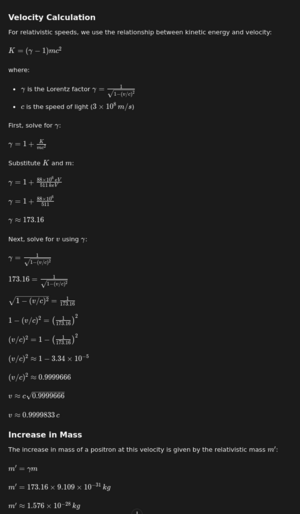Spaceships: Difference between revisions
Jump to navigation
Jump to search
No edit summary |
No edit summary |
||
| (One intermediate revision by the same user not shown) | |||
| Line 14: | Line 14: | ||
= Lorentz = | = Lorentz = | ||
[[File:Lorentz Velocity.png|thumb]] | [[File:Lorentz Velocity.png|thumb]] | ||
* K = (gamma - 1)(mc^2) | |||
* gamma = 1 + K/(m * c^2) | |||
* v=c*sqrt(1-((1/gamma)^2)) | |||
v=c*sqrt(1-((1/gamma)^2)) | * gamma = 1 / (sqrt(1-((v/c)^2))) | ||
* sqrt(1-((v/c)^2)) = 1/gamma | |||
* 1-((v/c)^2) = (1/gamma)^2 | |||
* (v/c)^2 = 1-((1/gamma)^2) | |||
* v/c = sqrt(1-((1/gamma)^2)) | |||
* v = c * sqrt(1-((1/gamma)^2)) | |||
Latest revision as of 01:42, 6 June 2024
Cyclotron Basics for a Proton
The kinetic energy K of a proton in a cyclotron is given by:
K=(q^2 * B^2 * R^2)/(2m)
where:
- q = charge of the proton (1.602×10−19 coulombs), electron is negative that
- B = magnetic field strength (teslas, 10 is a lot, 20 is a lot lot)
- r = radius of the cyclotron (meters)
- m = rest mass of the proton (1.673×10−27 kilograms), electron is 9.109×10−31
Lorentz
- K = (gamma - 1)(mc^2)
- gamma = 1 + K/(m * c^2)
- v=c*sqrt(1-((1/gamma)^2))
- gamma = 1 / (sqrt(1-((v/c)^2)))
- sqrt(1-((v/c)^2)) = 1/gamma
- 1-((v/c)^2) = (1/gamma)^2
- (v/c)^2 = 1-((1/gamma)^2)
- v/c = sqrt(1-((1/gamma)^2))
- v = c * sqrt(1-((1/gamma)^2))
